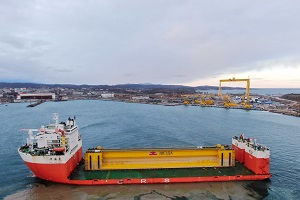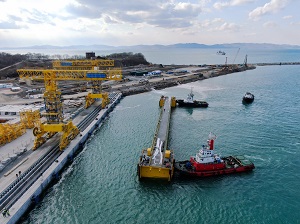Please activate JavaScript in your browser to use all interface options.
Floating Bulkhead for Russia’s largest Dry Dock delivered to Zvezda Shipyard
28 April 2020-350x1000.jpg)
The transportation of unique equipment for the largest Russian dry dock under construction at the Zvezda Shipyard has been successfully completed in the town of Bolshoy Kamen.
Floating bulkhead (watertight gate) is a floating structure 114 metres long and 12 metres high. It was delivered by sea on the deck of a 180 metre semi-submersible transport vessel. The berthing and mooring of the floating bulkhead to the outfitting quay of the Zvezda Shipbuilding Complex took 16 hours.
The floating bulkhead assembling is scheduled for July 2020.  The object is to separate the dock chamber, the bottom of which is below water level, from the water area. The working principle of the floating bulkhead is as follows: once the assembly of the vessel is completed, the dry dock is filled with seawater; when the water level in the dock is equal to the water area level, the floating bulkhead is lifted thus opening the entrance. Following that, the vessel is taken out of the dock.
The object is to separate the dock chamber, the bottom of which is below water level, from the water area. The working principle of the floating bulkhead is as follows: once the assembly of the vessel is completed, the dry dock is filled with seawater; when the water level in the dock is equal to the water area level, the floating bulkhead is lifted thus opening the entrance. Following that, the vessel is taken out of the dock.
During operation, the floating bulkhead will take up a position on either side of the dock sill. This shape reduces steel construction weight and allows the floating bulkhead to stand on the threshold of a dry dock with empty ballast tanks. This makes it possible not to heat the tanks in wintertime and to repair the floating bulkhead without shutting it down. In addition, the floating bulkhead has a high level of unsinkability.
Another feature is the floating bulkhead’s upper deck. It is equipped with a traffic area.
 The body of the floating bulkhead made of shipbuilding high-strength steel has a continuous waterproof jacket and divided by decks and bulkheads into the air, ballast, and open compartments. The floating bulkhead includes a diesel generator, dehydrating systems, ballast systems, ventilation system, dry dock filling valves, local fire extinguishing system, and fire alarm. Ballast tanks and the floating bulkhead’s space are equipped with a heating system filled with antifreeze heat-carrying medium. The floating bulkhead is operated by the central console and local posts.
The body of the floating bulkhead made of shipbuilding high-strength steel has a continuous waterproof jacket and divided by decks and bulkheads into the air, ballast, and open compartments. The floating bulkhead includes a diesel generator, dehydrating systems, ballast systems, ventilation system, dry dock filling valves, local fire extinguishing system, and fire alarm. Ballast tanks and the floating bulkhead’s space are equipped with a heating system filled with antifreeze heat-carrying medium. The floating bulkhead is operated by the central console and local posts.
The dry dock is a key element of the second stage of the Zvezda Shipbuilding Complex, the country’s largest hydraulic structure with dimensions of 485х114х14 metres. The dry dock will allow the construction of most types of existing and prospective ships with virtually no limit to the tonnage and launching weight of the hulls.
At the moment, the work on a foundation pit structure of the dry dock has been fully completed; concreting of the main structures--walls, bottom, and the main pumping station--comes to a close. Pumping and lifting equipment has been delivered, including the Goliath gantry crane with a lifting capacity of 1,200 tonnes.
Note for Editors:
The Zvezda Shipbuilding Complex is being created in the town of Bolshoy Kamen (Primorsky Territory) by the Rosneft-led Consortium on behalf of the President of Russia Vladimir Putin.
The Shipyard’s order portfolio exceeds 40 vessels (approximately 60 vessels including options) at the moment. The Shipyard’s pilot throughput is provided for by Rosneft that placed an order for 28 vessels.
Zvezda’s product line will include tankers of up to 350k tonnes displacement, ice-class vessels, vessels for cargo transportation, specialty vessels, and other types of marine equipment of any complexity, characteristics and purposes, including those that had not previously been produced in Russia due to the lack of required launching and hydraulic structures.
The construction of the second stage of the Zvezda Shipyard is currently underway. The first vessels are under construction at the finished facilities of the first stage: the block of hull production, paint booths, a heavy open outfitting berth equipped with the Goliath gantry crane with a lifting capacity of 1,200 tonnes and a floating transfer dock with a loading capacity of 40,000 tonnes.
In the final stage of construction are the block assembly shop and the key element of the second stage--the dry dock--one of the world’s largest hydraulic structures with dimensions of 485х114х14 metres. The dry dock will be equipped with the Goliath gantry crane with a lifting capacity of 1,200 tonnes.
Rosneft
Information
Division
April 28, 2020

-315xx70.png)

